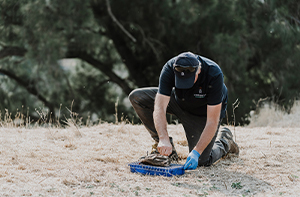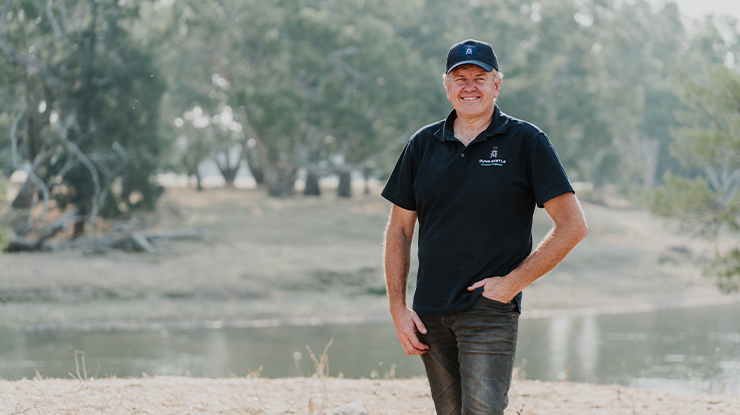 Dr Russ Barrow, CSU Technical Research Coordinator. Image: Dung Beetle Ecosystem Engineers (DBEE).
Dr Russ Barrow, CSU Technical Research Coordinator. Image: Dung Beetle Ecosystem Engineers (DBEE).
Dung Beetle Ecosystem Engineers (DBEE) researcher, Charles Sturt University Technical Research Coordinator Dr Russ Barrow, is monitoring the distribution, abundance and diversity of dung beetles.
It’s an important part of the MLA‑supported project to map the distribution of dung beetles across various climatic zones and introduce species that are well‑adapted to specific regions for year‑round activity.
“We do monthly monitoring of more than 100 intensive surveillance sites over one to two years to definitively establish where various beetle species have adapted regionally and become successfully established,” Russ said.
“We monitor beetle activity over a two‑day period. We contact producers first for approval to access their land, before heading out to set our traps and returning 24 hours later to evaluate and record the samples.”
Setting the traps
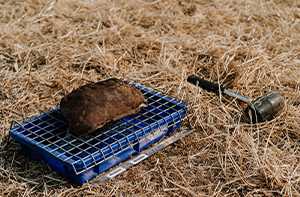
The team collects information about each farm, such as soil types and stocking rates, to ensure traps are located across a variety of environmental conditions.
Four traps are used at each site, taking into account the site’s topography, soil types and livestock presence, to assess whether a species of beetle is dominating a particular environment.
Above‑ground pitfall traps are used – plastic containers containing a litre of a preserving agent and covered with a grate and topped with a kilogram of dung. The beetles are attracted to the dung and fall through the grate, into the agent.
Meet one of the producers who hosted traps on his farm here.
Delicious dung
Dung selection is an important consideration when trapping beetles, as species can have specific preferences for particular dung.
“We’re often asked why we import new beetle species to Australia when we have more than 500 unique species currently established here,” Russ said.
“The simple answer is because native species frequently have a strong preference for Australian marsupial dung, whereas the 23 species of dung beetles successfully introduced to Australia by CSIRO research teams typically have a preference for the dung of introduced herbivores such as sheep and cattle.
“This is where we’ll add the greatest value in Australian grazing systems through beetle introduction.”
Counting beetles
The DBEE monitoring team returns to traps as close to 24 hours after setting them as possible, to examine the contents.
“The number of beetles trapped can vary by site,” Russ said.
“Last time we did our Wagga Wagga–Gundagai monitoring loop, we had an abundance of the winter‑active dung beetle Bubas bison, with some traps attracting hundreds of them.”
Reporting back
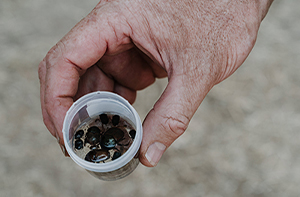
Russ said the monitoring program is part of a bigger effort dedicated to providing producers with easily accessible information on dung beetle distribution, and feeds into beetle databases and maps on the DBEE website.
It all comes down to definitively evaluating species’ preferences for climatic zones and seasonal activity patterns.
“We want to introduce multiple species in each region to fill seasonal gaps, ensuring producers reap dung beetle benefits year‑round,” Russ said.
His team assesses the contents of the traps in‑field to report on the diversity of beetle species, then takes all samples back to Charles Sturt University. Samples are later sent to the University of Western Australia for taxonomic examination.
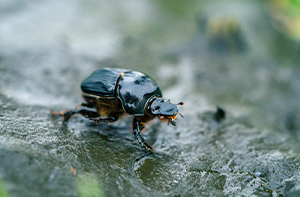
Risk‑free benefits
Russ said producers often ask him if there are risks to introducing dung beetles and if they can be harmful for the environment.
“It’s perfectly reasonable for producers to be sceptical as previously introduced species of fauna, such as the cane toad, have had devastating impacts,” Russ said.
In more than 50 years of gathering information on dung beetles, he hasn’t turned up any negative impacts of the introduced species.


